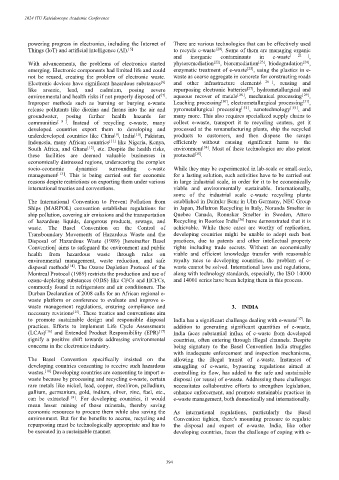Page 438 - Kaleidoscope Academic Conference Proceedings 2024
P. 438
2024 ITU Kaleidoscope Academic Conference
powering progress in electronics, including the Internet of There are various technologies that can be effectively used
[5]
Things (IoT) and artificial intelligence (AI). to recycle e-waste [20] . Some of them are managing organic
and inorganic contaminants in e-waste [ 21 ] ,
With advancements, the problems of electronics started phytoremediation [22] , bioremediation [23] , biodegradation [24] ,
emerging. Electronic components had limited life and could enzymatic treatment of e-waste [25] , using the plastics in e-
not be reused, creating the problem of electronic waste. waste as coarse aggregate in concrete for constructing roads
Electronic devices have significant hazardous substances and other infrastructure elements [ 26 ] , reusing and
[6]
like arsenic, lead, and cadmium, posing severe repurposing electronic batteries [27] , hydrometallurgical and
environmental and health risks if not properly disposed of . aqueous recover of metals [ 28] , mechanical processing [ 29] ,
[7]
Improper methods such as burning or burying e-waste Leaching processing [30] , electrometallurgical processing [31] ,
release pollutants like dioxins and furans into the air and pyrometallurgical processing [ 32 ] , nanotechnology [ 33 ] , and
groundwater, posing further health hazards for many more. This also requires specialized supply chains to
communities [ 8 ] . Instead of recycling e-waste, many collect e-waste, transport it to recycling centers, get it
developed countries export them to developing and processed at the remanufacturing plants, ship the recycled
underdeveloped countries like China , India [10] , Pakistan, products to customers, and then dispose the scraps
[9]
Indonesia, many African countries [11] like Nigeria, Kenya, efficiently without causing significant harm to the
South Africa, and Ghana [12] , etc. Despite the health risks, environment [34] . Most of these technologies are also patent
these facilities are deemed valuable businesses in protected [35] .
economically distressed regions, underscoring the complex
socio-economic dynamics surrounding e-waste While they may be experimented in lab-scale or small-scale,
management [ 13 ] . This is being carried out for economic for a lasting solution, such activities have to be carried out
reasons despite restrictions on exporting them under various in large industrial scale, in order for it to be economically
international treaties and conventions. viable and environmentally sustainable. Internationally,
some of the industrial scale e-waste recycling plants
The International Convention to Prevent Pollution from established in Daimler Benz in Ulm Germany, NEC Group
Ships (MARPOL) convention establishes regulations for in Japan, Hellatron Recycling in Italy, Noranda Smelter in
ship pollution, covering air emissions and the transportation Quebec Canada, Ronnskar Smelter in Sweden, Attero
of hazardous liquids, dangerous products, sewage, and Recycling in Roorkee India [36] have demonstrated that it is
waste. The Basel Convention on the Control of achievable. While these cases are worthy of replication,
Transboundary Movements of Hazardous Waste and the developing countries might be unable to adopt such best
Disposal of Hazardous Waste (1989) [hereinafter Basel practices, due to patents and other intellectual property
Convention] aims to safeguard the environment and public rights including trade secrets. Without an economically
health from hazardous waste through rules on viable and efficient knowledge transfer with reasonable
environmental management, waste reduction, and safe royalty rates to developing countries, the problem of e-
disposal methods [14] . The Ozone Depletion Protocol of the waste cannot be solved. International laws and regulations,
Montreal Protocol (1989) restricts the production and use of along with technology standards, especially, the ISO 14000
ozone-depleting substances (ODS) like CFCs and HCFCs, and 14001 series have been helping them in this process.
commonly found in refrigerators and air conditioners. The
Durban Declaration of 2008 calls for an African regional e-
waste platform or conference to evaluate and improve e-
waste management regulations, ensuring compliance and 3. INDIA
necessary revisions [15] . These treaties and conventions aim
to promote sustainable design and responsible disposal India has a significant challenge dealing with e-waste [37] . In
practices. Efforts to implement Life Cycle Assessments addition to generating significant quantities of e-waste,
(LCAs) [16] and Extended Product Responsibility (EPR) [17] India faces substantial influx of e-waste from developed
signify a positive shift towards addressing environmental countries, often entering through illegal channels. Despite
concerns in the electronics industry. being signatory to the Basel Convention India struggles
with inadequate enforcement and inspection mechanisms,
The Basel Convention specifically insisted on the allowing the illegal transit of e-waste. Instances of
developing countries consenting to receive such hazardous smuggling of e-waste, bypassing regulations aimed at
wastes. [18] Developing countries are consenting to import e- controlling its flow, has added to the safe and sustainable
waste because by processing and recycling e-waste, certain disposal (or reuse) of e-waste. Addressing these challenges
rare metals like nickel, lead, copper, steel/iron, palladium, necessitates collaborative efforts to strengthen legislation,
gallium, germanium, gold, indium, silver, zinc, fuel, etc., enhance enforcement, and promote sustainable practices in
can be extracted [ 19 ] . For developing countries, it would e-waste management, both domestically and internationally.
mean lesser mining of those minerals, thereby saving
economic resources to procure them while also saving the As international regulations, particularly the Basel
environment. But for the benefits to accrue, recycling and Convention tighten, there's mounting pressure to regulate
repurposing must be technologically appropriate and has to the disposal and export of e-waste. India, like other
be executed in a sustainable manner. developing countries, faces the challenge of coping with e-
– 394 –

